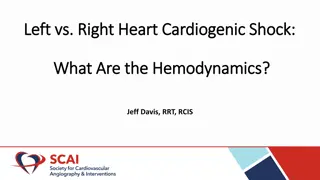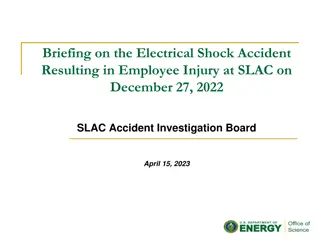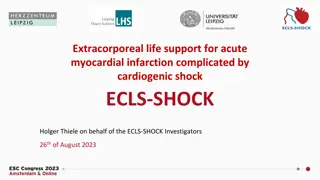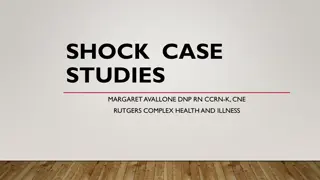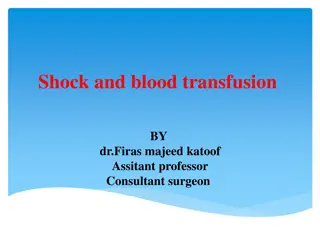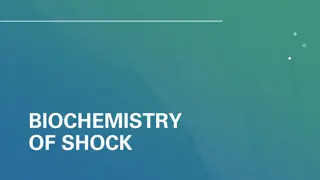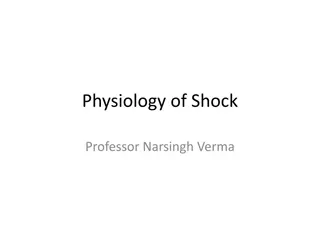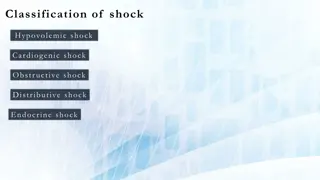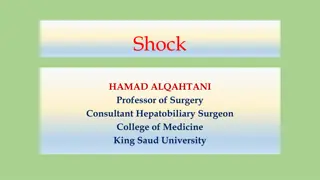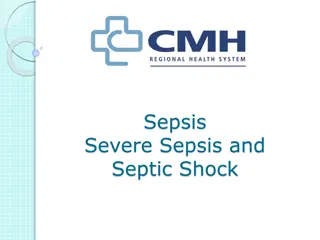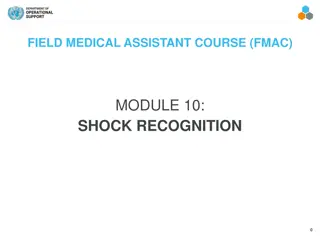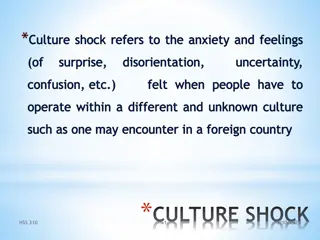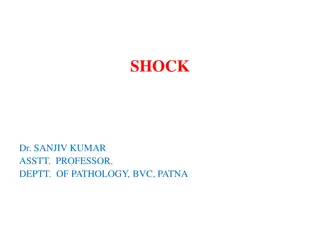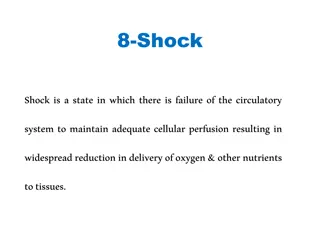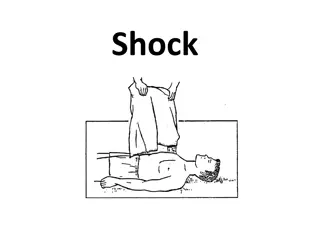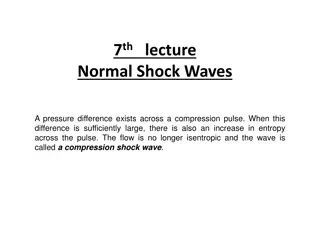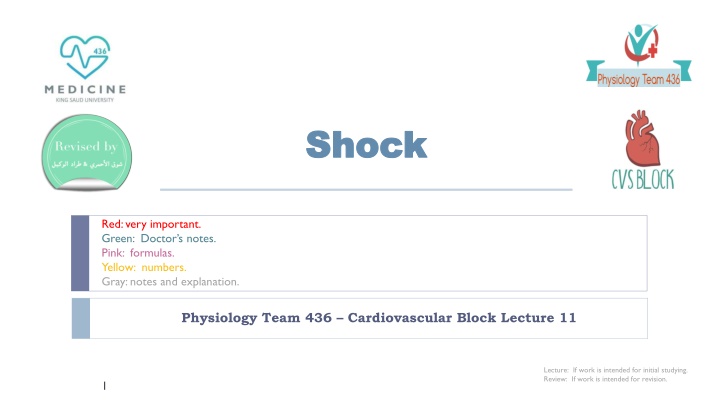
Shock: Causes, Mechanisms, and Complications
Explore the pathophysiology of shock, including circulatory shock, tissue perfusion, compensatory mechanisms, and different types of shock such as distributive, cardiogenic, hypovolemic, obstructive, and vasogenic. Learn about the critical stages of shock and how prompt intervention can prevent irreversible organ failure and death.
Download Presentation

Please find below an Image/Link to download the presentation.
The content on the website is provided AS IS for your information and personal use only. It may not be sold, licensed, or shared on other websites without obtaining consent from the author. If you encounter any issues during the download, it is possible that the publisher has removed the file from their server.
You are allowed to download the files provided on this website for personal or commercial use, subject to the condition that they are used lawfully. All files are the property of their respective owners.
The content on the website is provided AS IS for your information and personal use only. It may not be sold, licensed, or shared on other websites without obtaining consent from the author.
E N D
Presentation Transcript
Shock Shock Red: very important. Green: Doctor s notes. Pink: formulas. Yellow: numbers. Gray: notes and explanation. Physiology Team 436 Cardiovascular Block Lecture 11 Lecture: If work is intended for initial studying. Review: If work is intended for revision. 1
Objectives Study Smart: focus on mutual topics. Types and causes of shock. Define circulatory shock. Mechanisms responsible for the irreversible phase of hemorrhagic shock. Body compensatory mechanisms during reversible phases of hemorrhagic shock. Define shock and state the pathophysiological classification of shock. Describe the pathways leading to shock and decreased tissue perfusion. Discuss the stages of a hypovolemic shock. Explain how stage III hypovolemic shock might result in major organs failure. Discuss the different compensatory mechanisms during a hypovolemic shock. Describe the positive feedback mechanisms in the irreversible stage of a hypovolemic shock. 2
Shock The cell is the basic unit of life and it needs oxygen to produce energy. No oxygen No energy No life ONLY IN MALES SLIDES Shock may be defined as a pathophysiological state in which there is : 1-widespread 2- serious reduction of tissue perfusion Circulatory shock: When the circulatory system is unable to provide adequate circulation & tissue perfusion decreased availability of oxygen and nutrients to the tissues & vital body organs relative to its metabolic requirement cellular hypoxia and energy deficit . Result: organ dysfunction and cellular damage. (not death) failure to deliver oxygen which if prolonged :leads to generalized impairment of cellular function. Video of (Shock) Duration: (9;10 mins) If not quickly corrected: whole body failure irreversible shock and death. leads to Video of (Shock) Duration: (16:28 mins) 3
ONLY IN MALES SLIDES Pathways Leading to Decreased Tissue Perfusion and Shock Decreased tissue perfusion Causes: hemorrhage / hypovolemia - cardiac failure - neurologic injury. Result: immune and inflammatory responses. Alternatively, elaboration of microbial products during infection or release of endogenous cellular products from tissue injury cellular activation influences tissue perfusion and the development of shock . Systemic hypotension o NORMAL BP : 120/80 o LOW BP < 90/60 o Arterial pressure = cardiac output x systemic vascular resistance o Reduction in either component (cardiac output or vascular resistance) without a compensatory elevation of the other will result in hypotension. 4
Types of Shock MAP MAP = = CO CO X X PR PR MAP MAP = = CO CO X X PR PR Circulatory Shock (the problem is low cardiac output) (the problem is in peripheral resistance) High/Normal output shock Low output shock Distributive Cardiogenic Hypovolemic Obstructive Vasogenic: Septic/ toxic, Anaphylactic, Psychogenic Spinal: neurogenic - Is associated with loss of 40% or more of left ventricle myocardial function. - Mortality rate: 60%-90% Full playlist of Khan Academy s Shock-related videos 5
Causes and Classification of Shock TYPE CAUSES SYMPTOMS AND SIGNS 1. 2. Hypotension ( 85/40mmHg) ; weak but rapid pulse . Tachycardia (Compensation for MAP sensed by Baroreceptors) Rapid, weak, & thready pulse (140/min). Cool, clammy skin Tachypnea rapid respiration (Compensation for hypoxia sensed by Chemoreceptors) shallow breathing , anxiety Restlessness due to hypo-perfusion. Altered mental state Oliguria (low urine output)/ Anuria (no urine output). Blood test: Lactic acidosis. Bleeding/ Hemorrhage (internal/external) (Most Common) dehydration (sever vomiting, sever diarrhea, excess sweating) plasma loss (as in burns , trauma) low blood volume 3. 4. Hypovolemic shock (most common) 5. 6. 7. 8. 9. Lead to: Reduced venous return (preload) loss of 15-25% of CO / 1-2 L hypotension Heart problems (e.g., myocardial infarction(Most common), heart failure , cardiac dysrhythmias) despite adequate ventricular filling pressure contractility in stroke volume cardiac output hypotension Myocarditis, cardiomyopathy, cardiac tamponade, congestive heart failure Acute valvular dysfunction (e.g., rapture of papillary muscles post MI) Sustained arrhythmias (e.g. heart block, ventricular tachycardia) pulmonary embolism Is associated with loss of > 40% of LV myocardial function, mortality rate is high 60-90% 1. 2. 3. 4. 5. 6. Just like symptoms of a hypovolemic shock + Distended jugular veins Cardiomegaly Congestion of lungs & viscera: Chest X-ray (CXR): Interstitial pulmonary / Alveolar edema . May be absent pulse Cardiogenic shock Obstruction of venous return: like Vena Cava syndrome (usually neoplasms) Compression of heart: like hemorrhagic pericarditis > cardiac tamponade Obstruction of outflow: like aortic dissection*, massive pulmonary embolism, pneumothorax. Circulatory obstruction (e.g., constrictive pericarditis ) 1. 2. 3. Just like symptoms of a hypovolemic shock + Distended jugular veins Pulses paradoxes (in cardiac tamponade). Obstructive shock Lead to : reduced blood flow to lungs cardiac output hypotension 6 * Aortic dissection: aorta is weak, a cyst becomes a parallel vessel to aorta and makes it rupture > sudden death.
Causes and Classification of Shock High/Normal Cardiac Output Shock (Distributive) MAP MAP = = CO CO X X PR (the problem is in vascular/peripheral resistance) PR TYPE CAUSES SYMPTOMS AND SIGNS Septic shock: infection release of bacterial toxins activation of NOS in macrophages production of NO vasodilation + endothelial injury decreased vascular resistance hypotension Septic shock: Patient flushed & warm due to his hyperdynamic state - Severe drop in BP or hemoglobin- fever warm- sweaty skin and hypotension Distributive shock 1- Vasogenic (Valvular Obstruction) 2- Low- resistance shock Anaphylactic shock: allergy (release of histamine) IgE Mediated hypersensitivity (histamine triggers peripheral vasodilation and an increase in capillary permeability decreased vascular resistance hypotension Anaphylatic shock: hypotension- skin eruptions- breathlessness- coughing - localized edema- weak - rapid pulse Neurogenic shock: / Spinal Shock (venous pooling): spinal injury peripheral vasomotor tone loss of autonomic and motor reflexes vasodilation Blood volume remains normal in peripheral vascular resistance cardiac output as blood is pooled in peripheral veins Capacity of blood Venous return hypotension (Behaves like hypovolemic shock) Neurogenic shock: as for hypovolemic except warm, dry skin Psychogenic shock : Simple fainting (syncope) Psychogenic shock : stress, pain, or fright HR & vessels dilate Brain becomes hypo perfused Loss of consciousness. 7
Pathophysiology of Shock Reduce capillary perfusion Inadequate tissue oxygen Metabolic acidosis Shift to anaerobic metabolism Release of free radical and oxidative stress - Reactive Oxygen Species (ROS) Apoptosis (programed cell death) Tissue damage 8
ONLY IN FEMALES SLIDES Metabolic Changes & Cellular Response to Shock 1- Reduced capillary perfusion: Anaerobic metabolism ( anaerobic glycolysis) Failure of Na/k pump ( Na & Ca inside the cell) Lysosomes, nuclear membranes & mitochondrial breakdown Hypoxic tissue damage (oxidative stress) Metabolic acidosis (intracellular acidosis) Spasm of pre-post capillary sphincters Lactic acid production 2- After 3-5 hours of shock: Hypoxia continue +Fluid leaves extra vascular compartment. (which will drain in lymphatic vessel) Further reduction in circulating blood volume. Precapillary sphincters dilate Venules are still constricted. Blood stagnation in capillaries. 3- granulocytes accumulation at injured vessels: ( Free radical release and further tissue damage). 4- damage in GIT mucosa : allows bacteria into circulation. 9
ONLY IN FEMALES SLIDES Cont. 5- cerebral ischemia further decrease in blood pressure depression of vasomotor center (sympathetic) vasodilation+ HR 6- Myocardial ischemia depressed contractility+ myocardial damage(more shock and acidosis). 7- respiratory distress syndrome occurs : due to damage of capillary endothelial cells & alveolar epithelial cells with release of cytokines. 8- multiple organ failure and death. 10
ONLY IN MALES SLIDES Compensatory Mechanisms During Hypovolemic Shock 1. 2. 3. 4. 5. Cardiovascular. Respiratory. Endocrine. Renal. Others. Regulation of BP Other Intermediate and long term mechanisms Short term mechanisms Increased 2,3 DPG Restoration of plasma volume Restoration of plasma proteins Restoration of RBCs Capillary shift Baroreceptor reflex Chemoreceptor reflex CNS ischemic response Atrial reflexes Hormonal Renal Video of (Compensatory Mechanisms of (Medical) Shock) Duration: (18:48 mins) Catecholamines ADH Short-term compensatory reactions: are rapid and act within seconds to minutes Other compensatory reactions: areactivated within hours From hours to days Intermediate-long term compensatory reactions: are activated within hours or From hours to days 11
ONLY IN FEMALES SLIDES Compensatory Mechanisms (The Important Ones) Baroreceptor reflex by decreased blood pressure Sympathetic stimulation Chemoreceptors reflex by acidosis Angiotensin II +III: powerful vasoconstrictors Renin-Angiotensin mechanism stimulation Aldosterone: Na & water retention Compensatory mechanism Water retention Release of antidiuretic hormone (vasopressin) Vasoconstriction and thirst stimulation Plasma protein synthesis Fluid shift mechanism 12
ONLY IN MALES SLIDES Short-Term Compensatory Mechanisms; 1- Arterial Baroreceptor Reflex Flow to the heart and brain is maintained; reductions in flow to other organs. 14 Fully explained in arterial pressure regulation lecture.
ONLY IN MALES SLIDES Cont. Total physical resistance Mean Arterial pressure 15 Fully explained in arterial pressure regulation lecture.
ONLY IN MALES SLIDES Short Term Compensatory Mechanisms; 2- Arterial Chemoreceptor Reflex Reductions in mean arterial blood pressure (MAP) below 60: do not evoke any additional responses through the baroreceptor reflex. stimulates peripheral chemoreceptors (aortic bodies, carotid bodies, heart) that sense changes in pO2, pCO2, and pH through tissue hypoxia and lactacidosis. 1. 2. This results in: Enhancement of the existing tachycardia and vasoconstriction Respiratory stimulation tachypnea 16 Fully explained in arterial pressure regulation lecture.
ONLY IN MALES SLIDES Compensatory Mechanisms During Hypovolemic Shock Arterial Baroreceptor and Chemoreceptor Reflexes Vasoconstriction (arteriolar constriction): this increases TPR and hence MAP. It is produced by: o Baroreceptor reflex. o Chemoreceptor reflex. o Noreadrenaline-adrenaline vasoconstrictor mechanism (due to activation of adrenal medulla). o Vasoconstriction is also produced by vasopressin-vasoconstrictor mechanism (in subsequent slides). Tachycardia Produced by: Baroreceptor reflex. Chemoreceptor reflex. Increased sympathetic activity. Tachypnea Caused by : activation of chemoreceptor reflex and sympathetic over activity. Importance: Increase O2 delivery. Increase thoracic pump activity help venous return. Marked in: Skin: cold, pale. kidneys: drop in GFR & urine volume. Viscera. Flow to the heart and brain is maintained; reductions in flow to other organs. o o o o The increased sympathetic activity also causes restlessness skeletal muscle activity help venous return. Important in: Shifting blood from the venous reservoir into the circulation. Maintaining filling pressure of the heart. o o 17
ONLY IN MALES SLIDES Compensatory Mechanisms During Hypovolemic Shock; Endocrine and Renal Mechanism: 1. Release of hormones that initiate vasoconstriction. 2. Renal conservation of salt and water. 3. Stimulation of hematopoeisis by erythropoietin These compensatory reactions are activated: Within hours From hours to days Endocrine and Renal Compensatory Mechanisms Stimulation of sympathetic nervous system release of epinephrine, norepinephrine from the adrenal medulla (sympatho-adrenal axis) . Epinephrin is released almost exclusively from adrenal medulla where as norepinephrin is released from adrenal medulla and sympathetic nerve endings. Vasoconstriction. o o o ADH is actively secreted by the posterior pituitary gland in response to hemorrhage. Thus, hemorrhage stimulates posterior pituitary synthesis and release of vasopressin (ADH). ADH is potent vasoconstrictor. It also stimulates reabsorption of water. o o o o Circulating vasoconstrictors o renal perfusion secretion of renin from juxtaglomerular apparatus generates angiotensin II Angiotensin II is a powerful vasoconstrictor o o 18
ONLY IN MALES SLIDES Cont. Endocrine and Renal Compensatory Mechanisms o secretion of glucocorticoids by adrenal cortex o This helps to maintain blood glucose o Stimulation of hematopoiesis o blood volume & hypoxia synthesis of erythropoeitin (EPO) hematopoiesis. Endocrine and Renal Compensatory Mechanisms o Vasopressin water reabsorption blood volume arterial pressure. o Angiotensin II release of aldosterone salt reabsorption blood volume arterial pressure. o arterial pressure in kidney decreases glomerular filtration rates and thereby decreases the excretion of water and electrolytes directly o Renal conservation of salt and water 19
ONLY IN MALES SLIDES Other Compensatory Mechanisms During Hypovolemic Shock These compensatory reactions are activated within hours or from hours to days 1. Responses activated: within hours Increased movement of interstitial fluid into capillaries (capillary fluid shift). Increased 2,3 DPG concentration in RBCs: This is important to help Hb deliver more O2 to the tissues (shift O2 dissociation curve to the right). 2. Responses activated: within hours-days Restoration of circulatory plasma volume: takes 12-72 hrs after moderate hemorrhage. Restoration of plasma proteins: this occurs in 2 stages: Rapid entry of preformed albumin from extracellular stores. Hepatic synthesis of proteins over 3-4 days. Restoration of RBCs: this occurs in 2 stages: Increase RBCs count in response to erythropoietin within 10 days. Restoration of red cell mass within 4-8 weeks. 20
ONLY IN FEMALES SLIDES In Normal Microcirculation Hydrostatic Pressure = 0 mmHg Osmotic Pressure = 3 mmHg NFP = - 5 to -7mmHg NFP = +5 to +10 mmHg Interstitial Fluid Interstitial fluid ArterialBlood Venous Blood Hydrostatic Pressure 18-20 mmHg Blood Capillary Colloid Osmotic Pressure 25 mmHg Hydrostatic Pressure 30-35 mmHg At arterial end: Water moves out of the capillary with a NFP of +5 to +10 mmHg Hydrostatic pressure dominates at the arterial end & net fluid flows out of the circulation. (Arterial pressure - Colloid osmotic pressure = + NFP filtration to interstitial fluid) At venous end: Water moves into the capillary with a NFP of -5 to -7 mmHg. Oncotic pressure dominates at the venous end & net fluid will flow into the bloodstream. ( Venous pressure - Colloid osmotic pressure = - NFP filtration to blood stream) NFP = Net Filtration Pressure 21
ONLY IN FEMALES SLIDES Fluid-Shift Mechanism In shock, the hydrostatic pressure decreases & oncotic pressure is constant, as a result: The fluid exchange from the capillary to the extracellular space decreases. The fluid return from the extracellular space to the capillary increases. That will increase the blood volume & will increase BP helping to compensate shock. The capillary fluid shift mechanism means simply that anytime capillary pressure falls too low, fluid is absorbed from the tissues through the capillary membranes and into the circulation, thus building up blood volume and increasing the pressure in the circulation. During Fluid-Shift Normally 22
ONLY IN FEMALES SLIDES Fluid-Shift Mechanism in Shock Hydrostatic Pressure 0mmHg Arterial Blood Venous Blood Interstitial fluid Decrease outflow Increase inflow Blood Capillary Hydrostatic pressure Hydrostatic Pressure Colloid Osmotic Pressure 20mmHg 10mmHg 25mmHg 23
ONLY IN MALES SLIDES Stages of Shock Stage 1 pressure and cardiac output are maintained (in recumbent position) Stage 2 pressure and cardiac output are not maintained ( 10-20 mmHg drop) Stage 3 pressure and cardiac output decrease is life threatening During Hypovolemic Shock : Pressure decreases , HR increases Bicarbonate decrease, Lactic acid increases 24
Possible Mechanism in the Development of Irreversible Shock Stages of Shock Shock Stimulus Reversible shock: (Compensated) Irreversible shock: Progressive Lysosomal Activation, Release Proteases Changes can be reversed by compensatory mechanism (neurohormonal activation) or by treatment. Defense mechanisms are successful in maintaining perfusion. Non-progressive Defense mechanisms begin to fall. Multi-organ failure. Complete failure of compensatory mechanisms. Can lead to death. Splitting of Plasma Proteins Vasoactive Peptides, Amines, etc. Hypotension, Fluid Loss Irreversible Shock 25
ONLY IN MALES SLIDES Stages of Shock Stage 2 (Progressive Stage) Stage 1 (Compensatory Stage) Happen if: When 20-40% of blood volume are lost, cardiac output cannot be maintained and falls markedly, even in the recumbent position. Happen in: In healthy individuals, acute blood loss of 10 15 % of the normal blood volume (e.g., blood donation) Results in : activation of the sympathetic nervous system. Symptoms: Arterial pressure is maintained Pressure decline when the patient assumes the erect position Increase in heart rate, Paleness and Anxiety Result in: 1- Fluid also moves from the interstitial to the intravascular compartment (i.e., reabsorption of tissue fluids). 2- there will be massive activation of the sympathetic nervous system Leading to: intense arteriolar constriction in the vascular beds of the kidney, gut, and skin redistribution of blood flow (i.e., centralization of blood flow) with larger fractions going to the vital organs (heart and brain) and smaller fractions going to the kidney, gut, and skin. Despite intense arteriolar constriction, systolic arterial BP declines by 10 to 20 mm Hg. Compensation is achieved acutely by: Increase in heart rate. Constriction of the arterioles. Thus, cardiac output is normal or slightly reduced especially when the patient assumes the erect position generalized vasoconstriction (increasing blood volume in the central circulation and tending to sustain venous return) 26
ONLY IN MALES SLIDES Cont. Stage 3 Stage 2 The compensatory mechanisms are maximally mobilized in stage II. Thus, Happen during : small additional losses of blood (>40 %) can result in life-threatening reduction in cardiac output, BP and tissue perfusion. Blood flow to heart, brain and kidney is further reduced severe ischemia and irreversible tissue damage this may result in impaired organ function and death. The severe vasoconstriction may itself become a complicating factor and initiate a vicious cycle The factors that determine the ultimate outcome include: Duration of stage III. Severity of tissue anoxia. Age and condition of the patient. (maximal mobilization of compensatory mechanisms) Symptoms, signs and complications: Systolic arterial blood pressure declines by 10-20 mmHg Tachycardia (heart rate increases and pulse is thready and weak) Skin is pale and cool (peripheral pallor is common) Deterioration of the mental state because the brain is getting less oxygen. Patient looks weak, tired and drowsy. Patient may show anxiety, aggressiveness, and restlessness. Thirst. Oliguria (urine output is decreased). Angina may occur in patients who have intrinsic coronary vascular disease. pH drops and metabolic acidosis develops due to increased anaerobic glycolysis 27
ONLY IN MALES SLIDES Irreversible Stage of Hypovolemic Shock (Stage 3) Mechanism In the irreversible stage of hypovolemic shock, a series of positive feed back mechanisms take place, leading to 1- further deterioration in cardiac output and MAP 2- more tissue hypoxia Depending on: the amount of blood lost How : When blood loss is excessive and not immediately replaced, and proper treatment is delayed, this stage is reached and the patient dies. In this stage, there is also failure of compensatory mechanisms. The severe vasoconstriction may itself become a complicating factor and initiate a vicious cycle. It could happen also during irreversible stage of hypovolemic shock Mechanism: 1- Impaired coronary perfusion cardiac ischemia depression of cardiac function further lowering of cardiac output. 2- Reduced blood flow to the vasomoter centers in the medulla depresses the activity of compensatory reflexes vasomotor failure depression of the activity of compensatory reflex depression of cardiac function further lowering of cardiac output. 3- Prolonged renal ischemia acute tubular necrosis may lead to prolonged post-shock renal insufficiency. 4- Bowel ischemia breakdown of the mucosal barrier . This may lead to entry of bacteria and toxins into the circulation depression of cardiac function further lowering of cardiac output Generalized cellular deterioration: Mitochondrial activity inside the cells in ATP. of cellular metabolism, especially glucose in ATP. in active transport of Na+ and K+ across the cell Na+ accumulation inside the cell. Rupture of many lysosomes. 28
Quiz https://www.onlineexambuilder.com/shock/exam-142187 Link to Editing File (Please be sure to check this file frequently for any edits or updates on all of our lectures.) References: Girls and boys slides. Guyton and Hall Textbook of Medical Physiology (Thirteenth Edition.) 29
Thank you! . The Physiology 436 Team: Team Leaders: Qaiss Almuhaideb Lulwah Alshiha Female Members: Rana Barasain Ashwaq Almajed Amal AlQarni Reema Alotaibi Leena Alwakeel Hayfaa Alshaalan Male Members: Faris Alnafeesah Nasser Abu-dujeen Contact us: Physiology436@gmail.com @Physiology436 30


